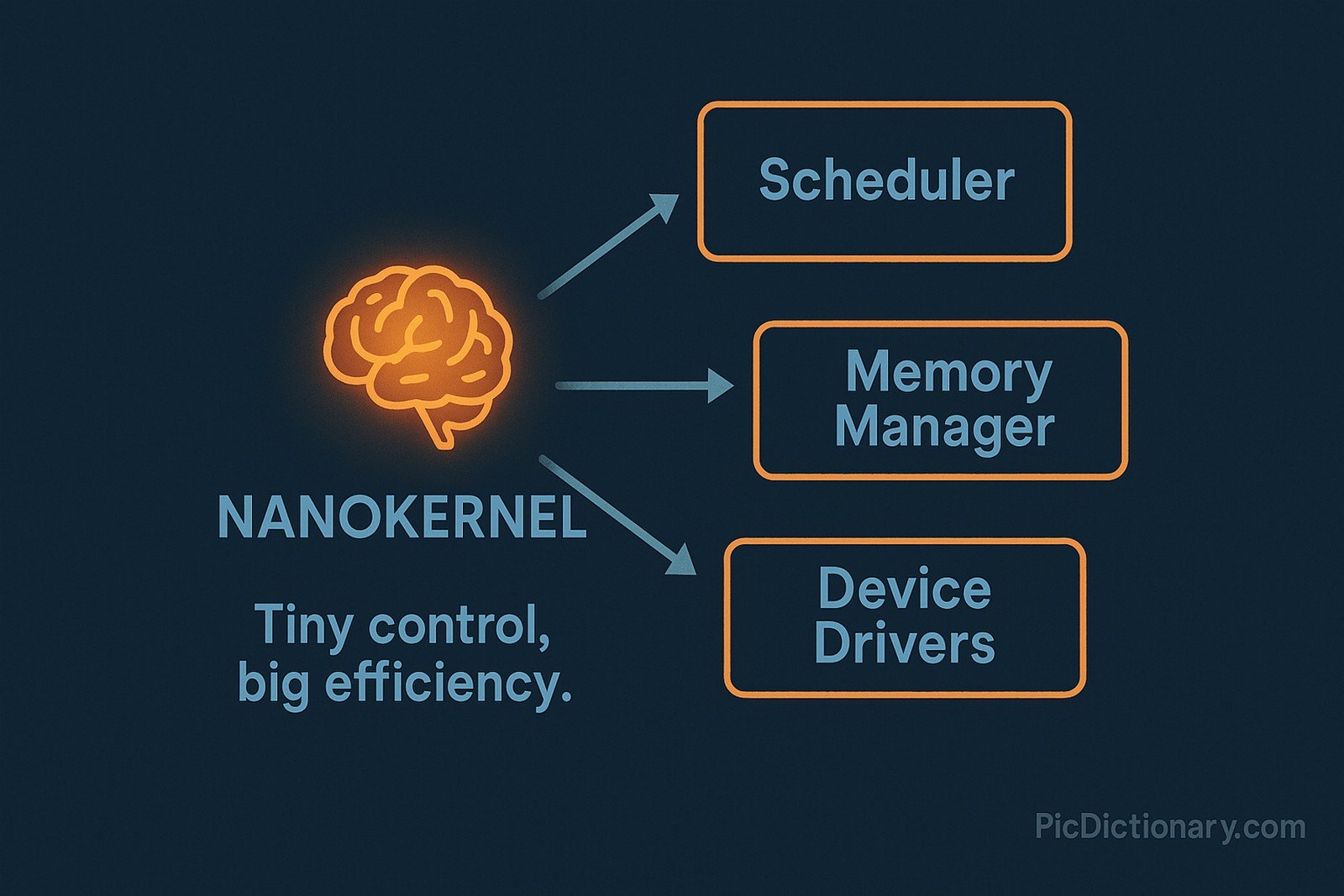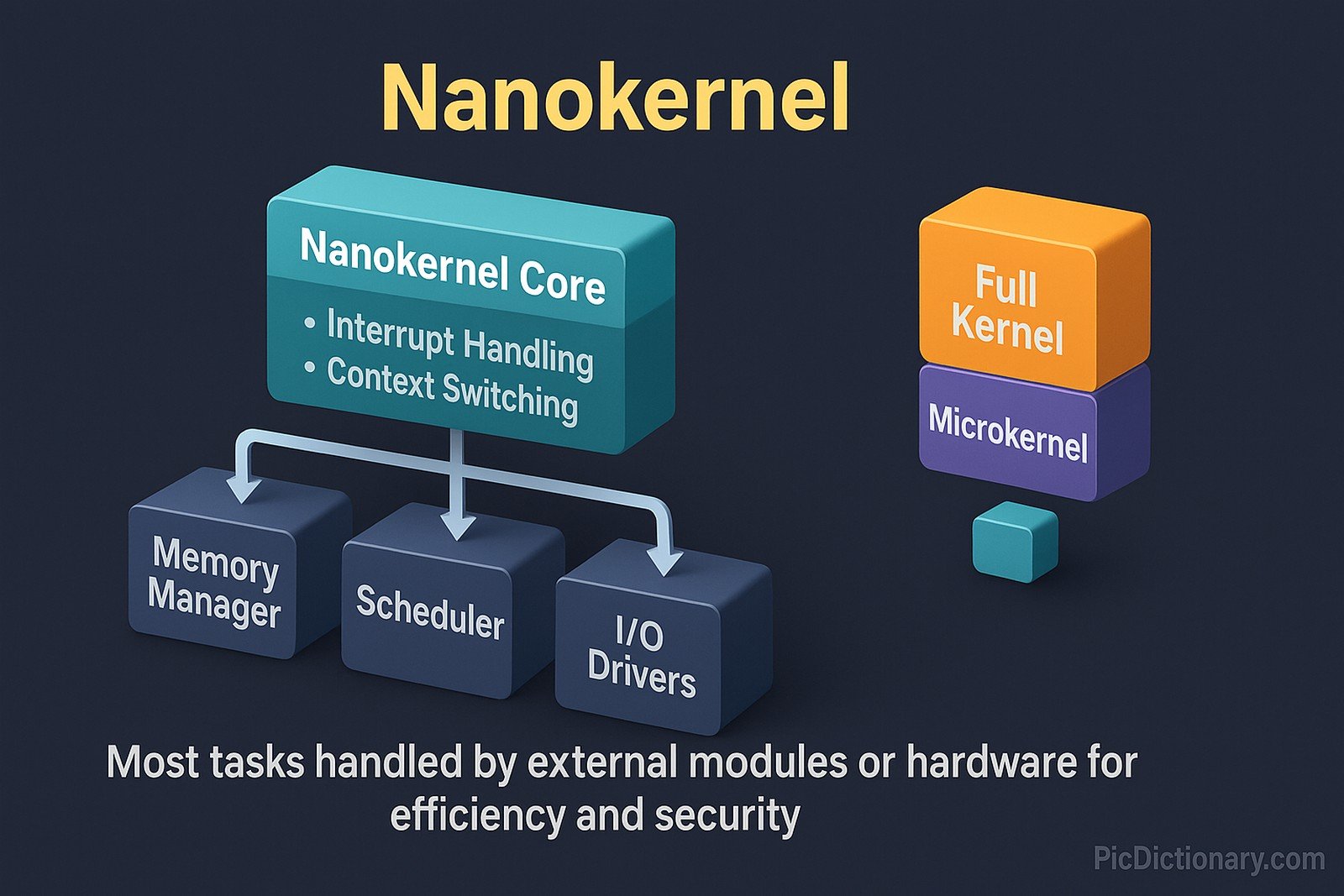Nanokernel
 (Representational Image | Source: Dall-E)
(Representational Image | Source: Dall-E)
Quick Navigation:
- Nanokernel Definition
- Nanokernel Explained Easy
- Nanokernel Origin
- Nanokernel Etymology
- Nanokernel Usage Trends
- Nanokernel Usage
- Nanokernel Examples in Context
- Nanokernel FAQ
- Nanokernel Related Words
Nanokernel Definition
A nanokernel is an ultra-lightweight type of operating system kernel designed to provide only the most minimal functionality required for system operations. Unlike monolithic kernels or even microkernels, nanokernels delegate most tasks, such as memory management and scheduling, to external processes or hardware, ensuring minimal overhead and high efficiency. They are used in environments where extreme minimalism and high security are required, such as embedded systems and specialized real-time applications.
Nanokernel Explained Easy
Think of a nanokernel as a tiny brain inside a computer. Imagine if your brain only did one thing: send signals to your body, and everything else was handled by separate parts. A nanokernel works like that—it does the absolute minimum, letting other parts of the system handle the heavy lifting. This makes it really fast and efficient!
Nanokernel Origin
Nanokernels emerged from research into minimal computing, where reducing system complexity was a priority. Early implementations appeared in the late 20th century as embedded systems became more sophisticated, requiring ultra-lightweight kernel solutions.
Nanokernel Etymology
The word "nanokernel" comes from "nano," meaning extremely small, and "kernel," referring to the core part of an operating system.
Nanokernel Usage Trends
Nanokernels have seen increasing use in security-critical and embedded environments. Their minimalistic nature reduces attack surfaces, making them ideal for military applications, secure computing, and low-power IoT devices. Additionally, modern hypervisors sometimes adopt nanokernel designs to optimize virtualization performance.
Nanokernel Usage
- Formal/Technical Tagging:
- Operating Systems
- Embedded Computing
- Real-Time Systems - Typical Collocations:
- "lightweight nanokernel design"
- "real-time nanokernel systems"
- "secure computing with nanokernels"
Nanokernel Examples in Context
- Many mission-critical embedded systems in aerospace use nanokernels to ensure minimal system overhead.
- Security-focused operating systems leverage nanokernels to minimize vulnerabilities.
- Some hypervisors use nanokernel architectures to improve virtualization efficiency.
Nanokernel FAQ
- What is a nanokernel?
A nanokernel is a minimal operating system kernel that provides only essential functionalities, delegating most tasks to external components. - How is a nanokernel different from a microkernel?
A nanokernel is even smaller than a microkernel, handling only the bare minimum required for system operation. - Where are nanokernels used?
They are commonly used in embedded systems, security-focused computing, and real-time applications. - What are the benefits of using a nanokernel?
They provide improved security, lower overhead, and greater efficiency for specialized applications. - Are nanokernels used in modern operating systems?
While not common in general-purpose OSes, nanokernels are used in specialized environments like IoT and security-focused systems. - Can a nanokernel run multiple applications?
Typically, they rely on external components to manage applications, focusing only on core system interactions. - Are nanokernels open source?
Some nanokernel implementations are open-source, but many are developed for proprietary, security-sensitive use cases. - Do nanokernels improve security?
Yes, their minimalistic nature reduces attack surfaces, making them a preferred choice for secure computing. - How do nanokernels compare to monolithic kernels?
Monolithic kernels integrate many system functions, while nanokernels offload most tasks, resulting in a smaller and faster system. - Is a nanokernel suitable for real-time systems?
Yes, nanokernels are often used in real-time applications where low latency and high efficiency are critical.

Nanokernel Related Words
- Categories/Topics:
- Minimalist OS Design
- Real-Time Computing
- Embedded Systems
Did you know?
One of the earliest uses of nanokernels was in military-grade secure systems, where minimizing system complexity reduced potential cyberattack vectors. Today, some space exploration systems also use nanokernels to ensure high reliability and low power consumption.
PicDictionary.com is an online dictionary in pictures. If you have questions or suggestions, please reach out to us on WhatsApp or Twitter.Authors | Arjun Vishnu | @ArjunAndVishnu

I am Vishnu. I like AI, Linux, Single Board Computers, and Cloud Computing. I create the web & video content, and I also write for popular websites.
My younger brother, Arjun handles image & video editing. Together, we run a YouTube Channel that's focused on reviewing gadgets and explaining technology.



Comments powered by CComment